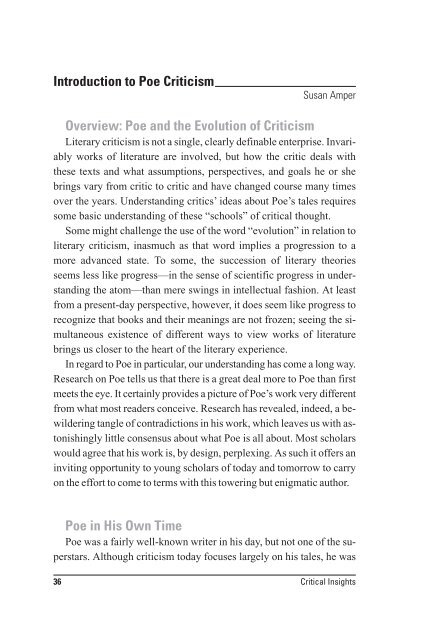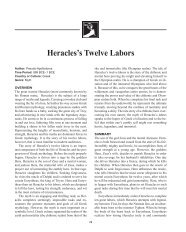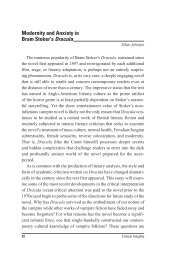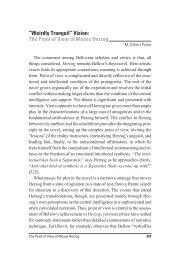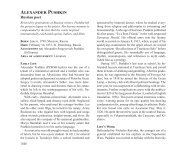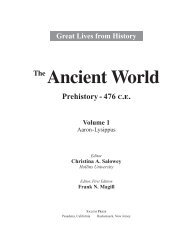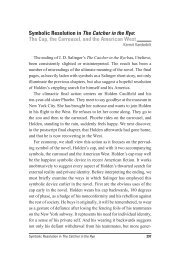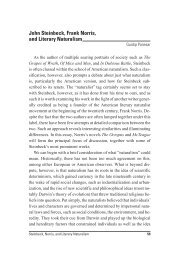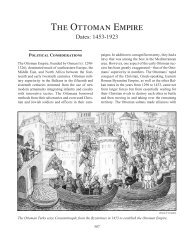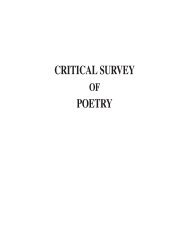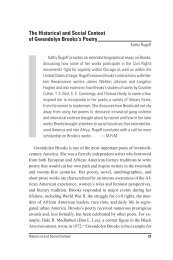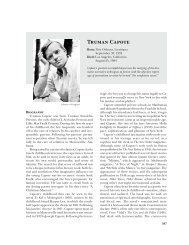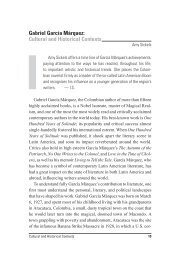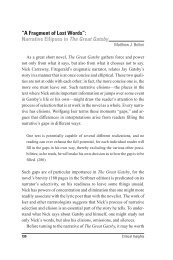Introduction to Poe Criticism Overview: Poe and the ... - Salem Press
Introduction to Poe Criticism Overview: Poe and the ... - Salem Press
Introduction to Poe Criticism Overview: Poe and the ... - Salem Press
You also want an ePaper? Increase the reach of your titles
YUMPU automatically turns print PDFs into web optimized ePapers that Google loves.
<strong>Introduction</strong> <strong>to</strong> <strong>Poe</strong> <strong>Criticism</strong><br />
Susan Amper<br />
<strong>Overview</strong>: <strong>Poe</strong> <strong>and</strong> <strong>the</strong> Evolution of <strong>Criticism</strong><br />
Literary criticism is not a single, clearly definable enterprise. Invariably<br />
works of literature are involved, but how <strong>the</strong> critic deals with<br />
<strong>the</strong>se texts <strong>and</strong> what assumptions, perspectives, <strong>and</strong> goals he or she<br />
brings vary from critic <strong>to</strong> critic <strong>and</strong> have changed course many times<br />
over <strong>the</strong> years. Underst<strong>and</strong>ing critics’ ideas about <strong>Poe</strong>’s tales requires<br />
some basic underst<strong>and</strong>ing of <strong>the</strong>se “schools” of critical thought.<br />
Some might challenge <strong>the</strong> use of <strong>the</strong> word “evolution” in relation <strong>to</strong><br />
literary criticism, inasmuch as that word implies a progression <strong>to</strong> a<br />
more advanced state. To some, <strong>the</strong> succession of literary <strong>the</strong>ories<br />
seems less like progress—in <strong>the</strong> sense of scientific progress in underst<strong>and</strong>ing<br />
<strong>the</strong> a<strong>to</strong>m—than mere swings in intellectual fashion. At least<br />
from a present-day perspective, however, it does seem like progress <strong>to</strong><br />
recognize that books <strong>and</strong> <strong>the</strong>ir meanings are not frozen; seeing <strong>the</strong> simultaneous<br />
existence of different ways <strong>to</strong> view works of literature<br />
brings us closer <strong>to</strong> <strong>the</strong> heart of <strong>the</strong> literary experience.<br />
In regard <strong>to</strong> <strong>Poe</strong> in particular, our underst<strong>and</strong>ing has come a long way.<br />
Research on <strong>Poe</strong> tells us that <strong>the</strong>re is a great deal more <strong>to</strong> <strong>Poe</strong> than first<br />
meets <strong>the</strong> eye. It certainly provides a picture of <strong>Poe</strong>’s work very different<br />
from what most readers conceive. Research has revealed, indeed, a bewildering<br />
tangle of contradictions in his work, which leaves us with as<strong>to</strong>nishingly<br />
little consensus about what <strong>Poe</strong> is all about. Most scholars<br />
would agree that his work is, by design, perplexing. As such it offers an<br />
inviting opportunity <strong>to</strong> young scholars of <strong>to</strong>day <strong>and</strong> <strong>to</strong>morrow <strong>to</strong> carry<br />
on <strong>the</strong> effort <strong>to</strong> come <strong>to</strong> terms with this <strong>to</strong>wering but enigmatic author.<br />
<strong>Poe</strong> in His Own Time<br />
<strong>Poe</strong> was a fairly well-known writer in his day, but not one of <strong>the</strong> superstars.<br />
Although criticism <strong>to</strong>day focuses largely on his tales, he was<br />
36 Critical Insights
etter known as a poet <strong>and</strong> probably best-known as a magazine edi<strong>to</strong>r<br />
<strong>and</strong> critic. Toward <strong>the</strong> end of his short life, he traveled about giving lectures<br />
on <strong>the</strong> poets <strong>and</strong> poetry of America, literary politics, <strong>and</strong> <strong>the</strong> function<br />
of criticism. As a reviewer, he was renowned for his talent <strong>and</strong><br />
taste for devastating pans, which earned him <strong>the</strong> sobriquet “Tomahawk<br />
Man.”<br />
<strong>Poe</strong> started his writing career as a poet <strong>and</strong> turned <strong>to</strong> s<strong>to</strong>ry writing<br />
mainly for financial reasons (though his tales also earned very little, in<br />
those days before copyright laws). He never s<strong>to</strong>pped writing poetry,<br />
however, <strong>and</strong> in 1845 published “The Raven,” which was sensationally<br />
popular. Prior <strong>to</strong> that time, when Henry Wadsworth Longfellow<br />
brought out a collection of American poems that did not include <strong>Poe</strong>’s<br />
work, <strong>and</strong> again when Rufus Griswold’s The <strong>Poe</strong>ts <strong>and</strong> <strong>Poe</strong>try of<br />
America came out with only three of <strong>Poe</strong>’s poems, <strong>Poe</strong> complained bitterly<br />
about this treatment. It seems that <strong>Poe</strong>’s reputation was high<br />
enough that he could reasonably claim unfairness but not so high that<br />
edi<strong>to</strong>rs felt obliged <strong>to</strong> make more room for him in <strong>the</strong> first place.<br />
The short s<strong>to</strong>ry at this time was just in <strong>the</strong> process of being invented.<br />
Indeed, <strong>Poe</strong> is credited, probably more than any o<strong>the</strong>r single writer,<br />
with creating <strong>and</strong> defining <strong>the</strong> genre. His tales were widely recognized<br />
for <strong>the</strong>ir power <strong>and</strong> artistry. One criticism, however, was repeatedly<br />
leveled at him during his career, <strong>and</strong> it has dogged him ever since: his<br />
Gothic sensationalism.<br />
As early as 1836, reviewers were lamenting what was <strong>the</strong>n referred<br />
<strong>to</strong> as <strong>Poe</strong>’s “Germanism.” One critic of <strong>the</strong> day described <strong>Poe</strong> as “<strong>to</strong>o<br />
fond of <strong>the</strong> wild—unnatural <strong>and</strong> horrible.” Why, this critic complained,<br />
“will he not disenthrall himself from <strong>the</strong> spells of German enchantment<br />
<strong>and</strong> supernatural imagery?” (Thomas <strong>and</strong> Jackson 202). T. W. White,<br />
<strong>the</strong> edi<strong>to</strong>r of The Sou<strong>the</strong>rn Literary Messenger, a prominent literary<br />
journal of <strong>the</strong> time, expressed <strong>the</strong> view of many. White generally admired<br />
<strong>Poe</strong>’s work but repeatedly complained about his use of “<strong>to</strong>o<br />
much German horror” <strong>and</strong> his blending of <strong>the</strong> “shadows of <strong>the</strong> <strong>to</strong>mb<br />
with <strong>the</strong> clouds of sunshine of life” (qtd. in Ingram 117).<br />
<strong>Introduction</strong> <strong>to</strong> <strong>Poe</strong> <strong>Criticism</strong> 37
In 1839 The Sou<strong>the</strong>rn Literary Messenger rejected what is <strong>to</strong>day<br />
considered one of <strong>Poe</strong>’s masterpieces, “The Fall of <strong>the</strong> House of<br />
Usher.” An edi<strong>to</strong>r, writing on behalf of White, <strong>to</strong>ld <strong>Poe</strong>:<br />
He doubts whe<strong>the</strong>r <strong>the</strong> readers of <strong>the</strong> Messenger have much relish for tales<br />
of <strong>the</strong> German School although [your tale is] written with great power <strong>and</strong><br />
ability....Idoubt very much whe<strong>the</strong>r tales of <strong>the</strong> wild, improbable <strong>and</strong> terrible<br />
class can ever be permanently popular in this country. (Harrison, 48:<br />
vol 17)<br />
<strong>Poe</strong>’s Gothicism was passé, <strong>the</strong> edi<strong>to</strong>r believed; people preferred <strong>the</strong><br />
more modern, realistic style of Charles Dickens.<br />
Time has proven <strong>the</strong> edi<strong>to</strong>r quite mistaken in his estimation of<br />
Americans’ tastes, for horror s<strong>to</strong>ries never disappeared, <strong>and</strong> in <strong>the</strong><br />
movie industry <strong>the</strong>y are perhaps <strong>the</strong> most consistently popular genre of<br />
all. But a note about <strong>the</strong> edi<strong>to</strong>r’s comments may be in order for readers<br />
new <strong>to</strong> <strong>Poe</strong>. Some readers view <strong>Poe</strong>’s Gothic tales reflexively as expressions<br />
of <strong>the</strong>ir author’s <strong>to</strong>rtured state of mind. This idea seems “natural.”<br />
His tales are so macabre, so focused on death, decay, <strong>and</strong> <strong>to</strong>rtured<br />
minds, that readers believe <strong>the</strong> obsessions reflect those of <strong>Poe</strong>.<br />
White, who knew <strong>Poe</strong> personally, thought no such thing. His point was<br />
not that <strong>Poe</strong> was personally obsessed with dark, subconscious terrors<br />
but that <strong>Poe</strong> was choosing <strong>to</strong> write in an unpopular genre. For White,<br />
<strong>the</strong> darkness <strong>and</strong> decay <strong>and</strong> terror were part of <strong>the</strong> Gothic genre, not<br />
<strong>Poe</strong>’s personality.<br />
Never<strong>the</strong>less, <strong>the</strong> idea that <strong>Poe</strong>’s tales are <strong>the</strong> reflection of his own<br />
psychological <strong>to</strong>rments has a long his<strong>to</strong>ry. The viewpoint was given its<br />
early shape by one very influential obituary, written by an acquaintance<br />
<strong>and</strong> bitter rival of <strong>Poe</strong>, Rufus Griswold. Writing under a pseudonym,<br />
Griswold published, two days after <strong>Poe</strong>’s death, an obituary of<br />
him in <strong>the</strong> New York Tribune. He wrote that <strong>the</strong> news of <strong>Poe</strong>’s death<br />
would cause “poignant regret among all who admire genius” but that<br />
few would grieve personally because of <strong>the</strong> kind of man <strong>Poe</strong> was. He<br />
38 Critical Insights
explicitly claimed that <strong>Poe</strong> himself was like <strong>the</strong> characters he created.<br />
Describing <strong>Poe</strong> as one of literature’s “most brilliant <strong>and</strong> erratic stars,”<br />
Griswold largely created <strong>the</strong> idea of <strong>Poe</strong> as an artistic genius <strong>to</strong>rmented<br />
<strong>to</strong> madness. Griswold exp<strong>and</strong>ed his profile in an introduction he wrote<br />
<strong>to</strong> what was for a time <strong>the</strong> definitive edition of <strong>Poe</strong>’s works. Griswold’s<br />
viewpoint was disputed by o<strong>the</strong>rs who knew <strong>Poe</strong> but was widely repeated<br />
<strong>and</strong> became popularly accepted.<br />
Reception in Europe<br />
The picture of <strong>Poe</strong> as <strong>the</strong> Romantic artist was enshrined by Charles<br />
Baudelaire, one of <strong>the</strong> greatest French poets of <strong>the</strong> nineteenth century.<br />
Baudelaire discovered <strong>Poe</strong>’s writings in 1852, three years after <strong>Poe</strong>’s<br />
death, <strong>and</strong> began translating his works <strong>and</strong> writing articles about him.<br />
In His<strong>to</strong>ires extraordinaires (1856) Baudelaire characterized <strong>Poe</strong> as<br />
<strong>the</strong> poète maudit (“accursed poet”), who suffered in <strong>the</strong> materialistic<br />
<strong>and</strong> commercial society of America yet was able <strong>to</strong> create <strong>the</strong> finest literature<br />
of his age. Baudelaire himself died broke <strong>and</strong> unrecognized,<br />
but he profoundly influenced <strong>the</strong> next generation of French poets,<br />
who enthusiastically seconded his appreciation of <strong>Poe</strong>. The French<br />
Symbolist movement, led by Stéphane Mallarmé, believed that <strong>the</strong> role<br />
of art was <strong>to</strong> give expression <strong>to</strong> <strong>the</strong> wild confusion of <strong>the</strong> poetic mind,<br />
reveling in symbolic language <strong>and</strong> literary artifice. <strong>Poe</strong> was <strong>the</strong>ir avatar.<br />
Admiration for <strong>Poe</strong> was expressed by o<strong>the</strong>r prominent European literary<br />
figures as well. In an 1861 introduction <strong>to</strong> three of <strong>Poe</strong>’s tales<br />
newly translated in<strong>to</strong> Russian, Dos<strong>to</strong>evsky declared that <strong>the</strong> “vigor of<br />
[<strong>Poe</strong>’s] imagination” distinguished him from every o<strong>the</strong>r author (61).<br />
In Engl<strong>and</strong>, Algernon Charles Swinburne, Oscar Wilde, <strong>and</strong> Dante Gabriel<br />
Rossetti lauded <strong>Poe</strong>. These writers, from Baudelaire on, are often<br />
considered <strong>to</strong> be <strong>the</strong> first modernists, <strong>and</strong> <strong>the</strong>ir praise recast <strong>Poe</strong> (whom<br />
<strong>the</strong> edi<strong>to</strong>r of The Sou<strong>the</strong>rn Literary Messenger had dismissed as retrograde)<br />
as a forefa<strong>the</strong>r of modernist writing.<br />
<strong>Introduction</strong> <strong>to</strong> <strong>Poe</strong> <strong>Criticism</strong> 39
The Europeans’ respect for <strong>Poe</strong> made its way back <strong>to</strong> America, but<br />
<strong>the</strong> process <strong>to</strong>ok time. In 1893, when a well-known literary magazine<br />
polled its readers on <strong>the</strong> <strong>to</strong>p ten books by American authors, <strong>Poe</strong> was<br />
scarcely even mentioned. In 1900, when <strong>the</strong> Hall of Fame for Great<br />
Americans was unveiled, designed <strong>to</strong> proclaim America’s place in<br />
world civilization, Ralph Waldo Emerson, Nathaniel Hawthorne <strong>and</strong><br />
Henry Wadsworth Longfellow were included; <strong>Poe</strong> was not. As scholars<br />
<strong>and</strong> o<strong>the</strong>r literary figures, including <strong>the</strong> Irish playwright George<br />
Bernard Shaw, criticized <strong>the</strong> omission, <strong>Poe</strong>’s reputation in his homel<strong>and</strong><br />
began <strong>to</strong> ascend. (He was voted in<strong>to</strong> <strong>the</strong> Hall of Fame in 1910.)<br />
In 1923, <strong>the</strong> English novelist D. H. Lawrence included an essay on<br />
<strong>Poe</strong> in his very influential book Studies in Classic American Literature.<br />
Two years later, <strong>the</strong> American poet William Carlos Williams published<br />
an essay presenting <strong>Poe</strong> as a pioneer of serious American literature.<br />
(Williams suggested, as Shaw had done, that <strong>Poe</strong>’s lack of stature<br />
in his native l<strong>and</strong> was a measure more of <strong>the</strong> defects of <strong>the</strong> American<br />
reading public than <strong>Poe</strong>’s true literary worth.) From that period onward,<br />
although <strong>Poe</strong>’s literary merit has been denigrated by a continuing<br />
stream of critics, his eminent position in <strong>the</strong> literary canon has not<br />
been shaken.<br />
Psychoanalyzing <strong>Poe</strong><br />
Much of what was written about <strong>Poe</strong> from <strong>the</strong> 1920’s through <strong>the</strong><br />
1940’s continued <strong>to</strong> focus on his presumed psychopathology. Lorine<br />
Pruette’s “A Psychoanalytic Study of Edgar Allan <strong>Poe</strong>,” John Robertson’s<br />
Edgar A. <strong>Poe</strong>: A Psychopathic Study, <strong>and</strong> Joseph Wood Krutch’s<br />
Edgar Allan <strong>Poe</strong>: A Study in Genius adopted <strong>the</strong> widely held view of<br />
<strong>Poe</strong> as an aberrant personality. Their attempts <strong>to</strong> uncover <strong>the</strong> nature<br />
<strong>and</strong> source of his aberration helped <strong>to</strong> perpetuate <strong>the</strong> perception. The<br />
most important of <strong>the</strong> psychoanalytic studies was that of Marie Bonaparte,<br />
published in French in 1933 <strong>and</strong> in English in 1949.<br />
Bonaparte was a friend of Sigmund Freud <strong>and</strong> adopted his view-<br />
40 Critical Insights
point about <strong>the</strong> nature of <strong>the</strong> unconscious. Like many critics working<br />
from psychoanalytic paradigms, in effect she treats <strong>Poe</strong> as a patient,<br />
examining his life <strong>and</strong> his work for clues <strong>to</strong> his psyche. She analyzes<br />
his tales as a psychoanalyst would parse a patient’s dreams: searching<br />
out <strong>the</strong> hidden symbolism that reveals <strong>Poe</strong>’s inner conflicts. Taking up<br />
“The Black Cat,” for example, she argues that <strong>the</strong> narra<strong>to</strong>r, whom she<br />
identifies with <strong>Poe</strong>, displaces his hatred of his mo<strong>the</strong>r on<strong>to</strong> <strong>the</strong> allblack<br />
cat, which he mutilates <strong>and</strong> kills for biting him. He is able, for a<br />
time, <strong>to</strong> regard <strong>the</strong> second cat as a good mo<strong>the</strong>r, because this one has a<br />
large splotch of white on its breast. The splotch, by its color <strong>and</strong> location,<br />
represents a mo<strong>the</strong>r’s milk; moreover, <strong>the</strong> second cat is found in a<br />
tavern (where one drinks), a<strong>to</strong>p a barrel of liquor.<br />
Bonaparte’s work is controversial. On one h<strong>and</strong>, she is praised for<br />
her keen insight in<strong>to</strong> <strong>the</strong> symbolic imagery in <strong>Poe</strong>’s tales. On <strong>the</strong> o<strong>the</strong>r<br />
h<strong>and</strong>, she is faulted, first, for her complete adherence <strong>to</strong> Freud’s <strong>the</strong>ories<br />
(which <strong>to</strong>day few analysts accept in <strong>the</strong>ir entirety) <strong>and</strong>, second, for<br />
her identification of <strong>Poe</strong> <strong>the</strong> man with his tales. The latter is an important<br />
issue, in terms of both <strong>Poe</strong>’s work in particular <strong>and</strong> our ideas about<br />
how <strong>to</strong> think about literature.<br />
Bonaparte takes <strong>Poe</strong>’s tales as expressions of himself. <strong>Poe</strong> writes <strong>the</strong><br />
tale; Bonaparte explains what it reveals about him. But while dreams<br />
may be <strong>the</strong> products of <strong>the</strong> dreamer’s unconscious, is not a short s<strong>to</strong>ry<br />
largely a conscious creation? <strong>Poe</strong> thought about how <strong>to</strong> draw his character,<br />
what setting <strong>to</strong> place him in, what would happen <strong>to</strong> him, <strong>and</strong> what<br />
he would say about <strong>the</strong>se things. How ought we <strong>to</strong> think about <strong>the</strong> end<br />
product: in terms of what it tells us about <strong>Poe</strong>, or what <strong>Poe</strong> is trying <strong>to</strong><br />
tell us about <strong>the</strong> world?<br />
An example may clarify this idea. Nathaniel Hawthorne, in tales<br />
such as “The Birthmark” <strong>and</strong> “Rappaccini’s Daughter,” writes of men<br />
who exhibit fears of women <strong>and</strong> end up killing <strong>the</strong>m. Yet few critics or<br />
general readers consider <strong>the</strong>se tales as expressing Hawthorne’s personal<br />
psychology. Ra<strong>the</strong>r, Hawthorne is seen as designing his tales in<br />
such a way that <strong>the</strong>y expose <strong>the</strong>se tendencies <strong>to</strong> our view. How is <strong>Poe</strong><br />
<strong>Introduction</strong> <strong>to</strong> <strong>Poe</strong> <strong>Criticism</strong> 41
different? He, <strong>to</strong>o, has invented male characters who show fears of<br />
women <strong>and</strong> ultimately kill <strong>the</strong>m. Why do readers think that <strong>Poe</strong> is<br />
merely expressing his own feelings, while Hawthorne is exposing ahuman<br />
condition? One possible difference is that Hawthorne’s thirdperson<br />
narra<strong>to</strong>rs point out <strong>the</strong>ir male characters’ insecurities. <strong>Poe</strong>’s<br />
first-person narra<strong>to</strong>rs do not. It is, however, widely agreed in <strong>the</strong> study<br />
of fiction that first-person narra<strong>to</strong>rs should not be identified with <strong>the</strong>ir<br />
authors, any more than a character in a play should be identified with<br />
his or her author.<br />
O<strong>the</strong>r critics also turned <strong>the</strong>ir attention, as Bonaparte did, <strong>to</strong> <strong>the</strong> way<br />
<strong>Poe</strong>’s s<strong>to</strong>ries symbolically depict unconscious struggles, but with an<br />
important difference. Instead of seeing <strong>the</strong> tales as expressions of <strong>Poe</strong>’s<br />
own insecurities <strong>and</strong> inner <strong>to</strong>rments, <strong>the</strong> s<strong>to</strong>ries are read as expositions<br />
of <strong>the</strong> human unconscious in general. This was <strong>the</strong> view D. H. Lawrence<br />
<strong>to</strong>ok. <strong>Poe</strong>’s tales of terror, for Lawrence, trace <strong>the</strong> disintegration<br />
of <strong>the</strong> human psyche. In Roderick Usher <strong>and</strong> in <strong>the</strong> narra<strong>to</strong>r of<br />
“Ligeia,” for example, Lawrence detected <strong>the</strong> image of vampires, who<br />
in <strong>the</strong>ir desire <strong>to</strong> know <strong>the</strong>ir female counterparts suck out <strong>the</strong>ir very<br />
life.<br />
Some scholars, while agreeing that <strong>Poe</strong>’s s<strong>to</strong>ries represented symbolic<br />
struggles, conceived <strong>the</strong>se struggles in different ways. Some<br />
viewed <strong>the</strong>m, as Baudelaire had, in terms of <strong>the</strong> artistic temperament,<br />
ei<strong>the</strong>r in conflict with itself or in opposition <strong>to</strong> external forces. <strong>Poe</strong>’s<br />
canonical tales of terror supported readings along <strong>the</strong>se lines. Roderick<br />
Usher is an artist; Ligeia is a brilliant philosopher. Critics also pointed<br />
<strong>to</strong> <strong>Poe</strong>’s longest work of fiction, The Narrative of Arthur Gordon Pym,<br />
which invites reading as <strong>the</strong> record of a visionary quest through <strong>the</strong><br />
realms of intellectual experience <strong>to</strong> some kind of denouement, whe<strong>the</strong>r<br />
tragic or ecstatic.<br />
Whe<strong>the</strong>r <strong>the</strong> conflict was construed as superego versus id or imagination<br />
versus reason, <strong>the</strong>se discussions share a common assumption:<br />
that <strong>the</strong> tales present <strong>the</strong>ir conflicts essentially in earnest. In <strong>the</strong> second<br />
half of <strong>the</strong> twentieth century, that perspective began <strong>to</strong> be displaced.<br />
42 Critical Insights
New Approaches<br />
In attempting <strong>to</strong> explicate <strong>Poe</strong>’s symbolism, <strong>the</strong> criticism of <strong>the</strong> late<br />
nineteenth <strong>and</strong> early twentieth centuries focused largely on <strong>the</strong>me—<br />
<strong>the</strong> idea of fiction being that it is designed <strong>to</strong> express an idea. Over<br />
time, literary scholars grew disenchanted with this conception, feeling<br />
that it limited readers’ experience of literature. To say that a certain<br />
s<strong>to</strong>ry or poem “means” a certain thing was called “reductive.” If one<br />
boils down a work of literature <strong>to</strong> its meaning, critics argued, all that is<br />
left is <strong>the</strong> meaning. One <strong>the</strong>reby misses what makes it art. The poet<br />
Archibald MacLeish summed up <strong>the</strong> new viewpoint in his oft-quoted<br />
lines, “A poem must not mean / But be.”<br />
In <strong>the</strong> 1920’s <strong>the</strong>re flourished in Russia a school of literary criticism<br />
known as formalism. Russian Formalists sought <strong>to</strong> analyze <strong>the</strong> text-initself,<br />
paying particular attention <strong>to</strong> its linguistic properties, as opposed<br />
<strong>to</strong> <strong>the</strong> his<strong>to</strong>rical or cultural conditions in which it was created. New <strong>Criticism</strong>,<br />
which peaked in Engl<strong>and</strong> <strong>and</strong> <strong>the</strong> United States in <strong>the</strong> 1940’s <strong>and</strong><br />
1950’s, resembles formalism in its focus on <strong>the</strong> text itself. New Critics<br />
called on readers <strong>to</strong> view poems <strong>and</strong> works of fiction as self-contained<br />
works of art, focusing on <strong>the</strong> way <strong>the</strong>y are constructed, <strong>the</strong>ir unifying principles.<br />
New <strong>Criticism</strong> gradually gave way <strong>to</strong> structuralism, which shares,<br />
however, an emphasis on how works of literature convey meanings.<br />
Surprising Discoveries<br />
When critics started analyzing how <strong>Poe</strong>’s tales are constructed, a<br />
fundamental shift began. Like <strong>the</strong> house of Usher with its barely detectable<br />
fissure running from <strong>to</strong>p <strong>to</strong> bot<strong>to</strong>m, <strong>Poe</strong>’s tales <strong>the</strong>mselves<br />
seemed on close inspection <strong>to</strong> be divided against <strong>the</strong>mselves. The tales<br />
of terror are prime examples. Horrifying <strong>the</strong>y certainly are, but <strong>the</strong>y are<br />
not simply horrifying. We experience <strong>the</strong>m also as complicated, puzzling,<br />
<strong>and</strong> at times almost comic. At some points <strong>the</strong>y read like metaphysical<br />
essays <strong>and</strong> at o<strong>the</strong>rs like cheap novels. <strong>Poe</strong> scholars set <strong>to</strong><br />
work <strong>to</strong> explain <strong>the</strong>se contradictions.<br />
<strong>Introduction</strong> <strong>to</strong> <strong>Poe</strong> <strong>Criticism</strong> 43
One dividing line, discussed in an important article by James<br />
Gargano, “The Question of <strong>Poe</strong>’s Narra<strong>to</strong>rs,” cuts between <strong>the</strong> s<strong>to</strong>ries<br />
<strong>and</strong> <strong>the</strong>ir narra<strong>to</strong>rs. Almost always <strong>Poe</strong>’s tales are narrated in <strong>the</strong> first<br />
person, by participants or at least on-<strong>the</strong>-scene observers. But what <strong>the</strong><br />
s<strong>to</strong>ries tell us, Gargano argues, is quite different from what <strong>the</strong> narra<strong>to</strong>rs<br />
are saying. <strong>Poe</strong>’s tales present <strong>the</strong> narra<strong>to</strong>rs’accounts, but in a way<br />
that allows <strong>the</strong> reader <strong>to</strong> see much more—including <strong>the</strong> failure of <strong>the</strong><br />
narra<strong>to</strong>rs <strong>to</strong> see. The narra<strong>to</strong>r of “William Wilson” is overwhelmed <strong>and</strong><br />
blind <strong>to</strong> what is happening <strong>to</strong> him, but <strong>the</strong> reader underst<strong>and</strong>s that <strong>the</strong><br />
man is in denial. The young man in “The Tell-Tale Heart” convinces<br />
himself that he is sane because he has rationally planned <strong>the</strong> old man’s<br />
murder; we see that fear <strong>and</strong> guilt have driven him insane. Montresor in<br />
“The Cask of Amontillado” believes he has cleverly avenged a wrong<br />
done <strong>to</strong> him; we see that he has inflicted a far greater injury on himself.<br />
For Gargano, <strong>Poe</strong>’s tales depict a moral universe. The narra<strong>to</strong>rs act,<br />
<strong>and</strong> speak, in blindness <strong>to</strong> this moral order but cannot escape it. G. R.<br />
Thompson, in his important book <strong>Poe</strong>’s Fiction: Romantic Irony in <strong>the</strong><br />
Gothic Tales, agrees that <strong>the</strong> tales reveal <strong>the</strong> blindness of <strong>the</strong>ir narra<strong>to</strong>rs.<br />
He views <strong>Poe</strong>, as many do, in <strong>the</strong> context of <strong>the</strong> Romantic tradition,<br />
which argues that man’s trust in reason is folly. <strong>Poe</strong> mocks rationalism,<br />
Thompson argues, by exposing his narra<strong>to</strong>rs’incomprehension<br />
of what is happening <strong>to</strong> <strong>the</strong>m. Thompson notes <strong>the</strong> self-parody that can<br />
be seen in <strong>Poe</strong>’s seemingly serious horror s<strong>to</strong>ries as fur<strong>the</strong>r examples of<br />
<strong>the</strong> author’s “ironic” stance.<br />
A valuable body of literature has emerged, analyzing specific tales<br />
in terms of <strong>the</strong> disparities between <strong>the</strong> narra<strong>to</strong>rs’versions of events <strong>and</strong><br />
<strong>the</strong> interpretations that readers may reach. Thus Gargano argues that<br />
<strong>the</strong> inability of <strong>the</strong> narra<strong>to</strong>r of “The Black Cat” <strong>to</strong> underst<strong>and</strong> <strong>the</strong> events<br />
he relates exposes his lack of moral vision (“Perverseness”). Benjamin<br />
Franklin Fisher believes that “The Assignation” reveals <strong>the</strong> limitations<br />
of its narra<strong>to</strong>r in appreciating <strong>the</strong> Romantic ideal (“Flights”). Marc<br />
Leslie Rovner sees William Wilson as <strong>to</strong>o obtuse <strong>to</strong> underst<strong>and</strong> his<br />
moral circumstances.<br />
44 Critical Insights
<strong>Poe</strong> as Parodist<br />
While <strong>the</strong> discovery of <strong>the</strong> contradictions in <strong>Poe</strong>’s tales led Thompson<br />
<strong>and</strong> o<strong>the</strong>rs <strong>to</strong> see irony, some saw parody <strong>and</strong> hoax. Clark Griffith<br />
argued that <strong>the</strong> Gothic horror tale “Ligeia” contained a disguised<br />
mockery of Transcendentalism. Richard P. Ben<strong>to</strong>n described <strong>the</strong> seemingly<br />
Romantic “The Assignation” as a hoax in which <strong>Poe</strong> parodies<br />
Thomas Moore’s account of Lord Byron’s affair with an Italian countess.<br />
Robert Regan saw “The Masque of <strong>the</strong> Red Death” as playing on<br />
Nathaniel Hawthorne’s “Legends of <strong>the</strong> Province House.” S<strong>to</strong>ries that<br />
most readers have taken <strong>and</strong> continue <strong>to</strong> take seriously were now often<br />
identified as hoaxes or parodies. Griffith read “Ligeia” as covertly parodying<br />
<strong>the</strong> Gothic tradition; Fisher <strong>to</strong>ok a similar view of “The Fall of<br />
<strong>the</strong> House of Usher” (“Germanism”); James M. Cox saw burlesque in<br />
both of those s<strong>to</strong>ries <strong>and</strong> “William Wilson” as well.<br />
To readers new <strong>to</strong> <strong>Poe</strong>, <strong>the</strong> idea that his seemingly dark <strong>and</strong> horrifying<br />
tales could be read as humorous is incredible. It is worthwhile,<br />
<strong>the</strong>refore, <strong>to</strong> consider <strong>the</strong> basis for such claims. In essence, <strong>the</strong> reasons<br />
are two.<br />
The first is <strong>Poe</strong>’s often abominable writing, a long-st<strong>and</strong>ing issue in<br />
<strong>the</strong> study of <strong>Poe</strong>. If he is such a great writer, <strong>the</strong> question is asked, why<br />
are his tales filled with passages that are overwrought, clichéd, or silly?<br />
For some, <strong>the</strong> answer is, <strong>Poe</strong> is not a great writer. <strong>Poe</strong>’s contemporary,<br />
<strong>the</strong> poet James Russell Lowell, mocked <strong>Poe</strong> as “three-fifths genius <strong>and</strong><br />
two-fifths sheer fudge.” The aris<strong>to</strong>cratic Henry James declared that “an<br />
enthusiasm for <strong>Poe</strong> is <strong>the</strong> mark of a decidedly primitive stage of reflection.”<br />
American-born English poet T. S. Eliot sneered that <strong>Poe</strong> had “<strong>the</strong><br />
intellect of a highly gifted young person before puberty.” English<br />
writer Aldous Huxley said that <strong>Poe</strong> was “cursed with incorrigible bad<br />
taste.” He considered <strong>Poe</strong>’s writing “vulgar,” like wearing a “diamond<br />
ring on every finger.” The highborn Irish poet William Butler Yeats<br />
also thought “vulgar” <strong>the</strong> best word. When a friend sent Yeats a copy of<br />
<strong>Poe</strong>’s poems that he had illustrated, Yeats wrote back <strong>to</strong> tell <strong>the</strong> illustra<strong>to</strong>r<br />
he was wasting his talents. The gifted poet described <strong>Poe</strong>’s work as<br />
<strong>Introduction</strong> <strong>to</strong> <strong>Poe</strong> <strong>Criticism</strong> 45
“vulgar <strong>and</strong> commonplace” <strong>and</strong> a few sentences later “insincere <strong>and</strong><br />
vulgar.” Such invective continues <strong>to</strong> <strong>the</strong> present day.<br />
<strong>Poe</strong>’s defenders often try <strong>to</strong> look beyond his flaws. The critic Allen<br />
Tate, who holds a generally favorable opinion of <strong>Poe</strong>, never<strong>the</strong>less<br />
confesses that “<strong>Poe</strong>’s serious style at its typical worst makes <strong>the</strong> reading<br />
of more than one tale at a sitting an almost insuperable task.” Tate<br />
notes how overripe <strong>Poe</strong>’s tales can be: <strong>the</strong> “Gothic glooms, <strong>the</strong> Venetian<br />
interiors, <strong>the</strong> ancient wine-cellars (from which nobody ever enjoys<br />
a vintage but always drinks ‘deep’)—all this, done up in a glutinous<br />
prose.” But, says Tate, <strong>Poe</strong> is worthy <strong>and</strong> readable if one is able <strong>to</strong> see<br />
through <strong>to</strong> “<strong>the</strong> power underlying <strong>the</strong> flummery.”<br />
Many scholars are unwilling <strong>to</strong> accept <strong>Poe</strong>’s excesses as defects. Instead,<br />
<strong>the</strong>y seek <strong>to</strong> explain <strong>the</strong>m as part of a deliberate design. Michael<br />
Allen, in a book published in 1969, argues that <strong>Poe</strong> designed his s<strong>to</strong>ries<br />
<strong>to</strong> appeal simultaneously <strong>to</strong> two different audiences. Allen’s analysis<br />
has been very influential <strong>and</strong> is worth underst<strong>and</strong>ing for <strong>the</strong> way it<br />
places <strong>Poe</strong> in <strong>the</strong> context of <strong>the</strong> literary marketplace of his time <strong>and</strong> <strong>the</strong><br />
way it deals with <strong>the</strong> contradictions that readers encounter in <strong>Poe</strong>’s<br />
tales.<br />
Allen argues that if one wishes <strong>to</strong> underst<strong>and</strong> <strong>Poe</strong>’s work, one must<br />
consider <strong>the</strong> most successful literary magazine of <strong>Poe</strong>’s time, Blackwood’s.<br />
Any magazine edi<strong>to</strong>r, as <strong>Poe</strong> was, would have spent time<br />
searching for <strong>the</strong> key <strong>to</strong> its success. That key, Allen went on, was <strong>the</strong><br />
ability of Blackwood’s <strong>to</strong> attract two distinct audiences: <strong>the</strong> unsophisticated<br />
“many” <strong>and</strong> <strong>the</strong> elite “few.” For <strong>the</strong> many, Blackwood’s offered<br />
plentiful helpings of sensationalism, literary gossip, <strong>and</strong> fiction; <strong>to</strong> <strong>the</strong><br />
highbrows it provided sophisticated burlesques, bits of curious <strong>and</strong> esoteric<br />
learning, serious criticism, <strong>and</strong> a pervasive <strong>to</strong>ne of superiority.<br />
<strong>Poe</strong> unders<strong>to</strong>od <strong>the</strong> magazine’s strategy <strong>and</strong> applied it <strong>to</strong> his own work.<br />
The result was a combination of lowbrow sensationalism, esoteric<br />
commentary, <strong>and</strong> sophisticated parody all within a single tale. Allen’s<br />
analysis accounts neatly for <strong>the</strong> contradictions—or <strong>the</strong> unevenness, as<br />
some would call it—that critics were pointing out in <strong>Poe</strong>’s tales. Al-<br />
46 Critical Insights
len’s focus on <strong>the</strong> economic considerations <strong>Poe</strong> faced, his need <strong>to</strong> win<br />
readers, inspired o<strong>the</strong>rs, including Jonathan Elmer, <strong>to</strong> explore <strong>the</strong> implications<br />
of <strong>Poe</strong>’s role or roles in <strong>the</strong> literary marketplace.<br />
Such analysis as Allen’s leaves some readers unsatisfied. It accounts<br />
for <strong>the</strong> defects in <strong>Poe</strong>’s tales, but <strong>the</strong> defects remain defects. We crave a<br />
“reading” of a tale in which <strong>the</strong> pieces fit <strong>to</strong>ge<strong>the</strong>r <strong>to</strong> serve an artistic<br />
purpose, not just a commercial one. <strong>Poe</strong> himself championed this idea,<br />
which he called “unity of effect.” In order <strong>to</strong> be regarded as great,<br />
should a writer not be in control of <strong>the</strong> effects his or her works have on<br />
readers? If we say that <strong>Poe</strong> is an able writer, <strong>and</strong> if readers commonly<br />
experience parts of his tales as meretricious, vulgar, or silly, <strong>the</strong>n we<br />
should be able <strong>to</strong> account for <strong>the</strong>se reactions in terms of <strong>the</strong> overall design<br />
of <strong>the</strong> tale—especially when <strong>the</strong> passages are so conspicuous, so<br />
pervasive, so seemingly central <strong>to</strong> our experience. Viewing <strong>the</strong> tales as<br />
parodies or hoaxes answers this need.<br />
<strong>Poe</strong> <strong>the</strong> Humorist<br />
Asecond fac<strong>to</strong>r that disposes many <strong>Poe</strong> scholars <strong>to</strong> see humor where<br />
<strong>the</strong> general reader sees only gloom <strong>and</strong> horror is <strong>the</strong> overall context of<br />
<strong>Poe</strong>’s work. Many readers know <strong>Poe</strong> from a h<strong>and</strong>ful of tales: “The Fall<br />
of <strong>the</strong> House of Usher,” “The Tell-Tale Heart,” “The Black Cat,” “The<br />
Cask of Amontillado,” <strong>and</strong> perhaps two or three o<strong>the</strong>rs. It comes as a<br />
surprise <strong>to</strong> such readers that of <strong>Poe</strong>’s more than sixty tales, about half<br />
are openly comical.<br />
“The System of Doc<strong>to</strong>r Tarr <strong>and</strong> Professor Fe<strong>the</strong>r” tells of a man<br />
who visits a mental hospital known for its revolutionary methods. The<br />
man is invited <strong>to</strong> stay for dinner by his hosts, who grow wilder through<br />
<strong>the</strong> evening until it is finally revealed that <strong>the</strong>se are in fact <strong>the</strong> inmates,<br />
who have overpowered <strong>the</strong>ir keepers <strong>and</strong> taken over <strong>the</strong> asylum. In<br />
“The Duc de L’Omelette,” a French duke dies <strong>and</strong> goes <strong>to</strong> hell. He maneuvers<br />
<strong>the</strong> devil in<strong>to</strong> a game of cards <strong>and</strong> escapes damnation by defeating<br />
him—palming a king while <strong>the</strong> devil takes a drink of wine.<br />
<strong>Introduction</strong> <strong>to</strong> <strong>Poe</strong> <strong>Criticism</strong> 47
“Why <strong>the</strong> Little Frenchman Wears His H<strong>and</strong> in a Sling” is <strong>to</strong>ld in dialect<br />
by Sir Pathrick O’Gr<strong>and</strong>ison Barronitt, who finds himself in competition<br />
with a Frenchman for <strong>the</strong> affections of <strong>the</strong> “purty widdy<br />
Misthress Tracle.” Seated <strong>to</strong>ge<strong>the</strong>r on a sofa, <strong>the</strong> men pursue <strong>the</strong><br />
woman through surreptitious h<strong>and</strong>holding. The passion with which Sir<br />
Pathrick feels his attentions returned convinces him that he has won,<br />
until <strong>the</strong> woman steps away, <strong>and</strong> he realizes that it is <strong>the</strong> Frenchman’s<br />
h<strong>and</strong> he holds. Infuriated, he crushes <strong>the</strong> Frenchman’s h<strong>and</strong>, <strong>the</strong>reby<br />
answering <strong>the</strong> question posed in <strong>the</strong> title. The list of such tales goes on<br />
<strong>and</strong> on.<br />
Perhaps more provocative than <strong>Poe</strong>’s burlesques is his taste for<br />
hoax. What is now called “The Balloon Hoax,” purports <strong>to</strong> tell <strong>the</strong><br />
s<strong>to</strong>ry of <strong>the</strong> first transatlantic balloon crossing. It was published in <strong>the</strong><br />
New York Sun without any indication that it was fiction. “The Facts in<br />
<strong>the</strong> Case of M. Valdemar” presents itself as <strong>the</strong> factual, eyewitness account<br />
of a professional hypnotist, who tells of hypnotizing his dying<br />
friend <strong>to</strong> see whe<strong>the</strong>r <strong>the</strong> trance could arrest his death. The patient remained<br />
unchanged for seven months, <strong>the</strong> author says, until <strong>the</strong> decision<br />
was made <strong>to</strong> awaken him from <strong>the</strong> trance. When this was done <strong>the</strong> man<br />
instantly rotted away <strong>to</strong> a liquid mass. So preposterous is <strong>the</strong> ending<br />
that one cannot imagine that <strong>Poe</strong> would think anyone would believe it,<br />
yet many did.<br />
By contrast, “Von Kempelen <strong>and</strong> His Discovery” is a deliberate<br />
hoax. In offering some details about its fictitious subject, <strong>the</strong> narra<strong>to</strong>r<br />
writes as though <strong>the</strong> basic news of Von Kempelen <strong>and</strong> his recent amazing<br />
discovery—how <strong>to</strong> turn lead in<strong>to</strong> gold—were already well known<br />
<strong>to</strong> <strong>the</strong> world. “The Premature Burial,” “The Unparalleled Adventure of<br />
One Hans Phall,” “The Journal of Julius Rodman,” <strong>and</strong> many o<strong>the</strong>r<br />
tales may also be regarded as hoaxes. Indeed, scholars <strong>the</strong>mselves disagree,<br />
so difficult is it <strong>to</strong> know when <strong>Poe</strong> is kidding.<br />
In this regard, two parodies are particularly significant. When “Silence—A<br />
Fable” was first published, it appeared under a title, “Siope—<br />
A Fable [in <strong>the</strong> manner of <strong>the</strong> Psychological Au<strong>to</strong>biographists],” that<br />
48 Critical Insights
clearly announced its parodic intent. But when readers <strong>to</strong>ok <strong>the</strong> tale seriously,<br />
<strong>Poe</strong> removed <strong>the</strong> subtitle (Regan 281). “Metzengerstein,” <strong>to</strong>o,<br />
was originally intended as a parody, but many readers <strong>to</strong>ok it as a genuine<br />
tale of <strong>the</strong> supernatural. <strong>Poe</strong> made one attempt <strong>to</strong> smarten his readers<br />
up: republishing in 1836, he added <strong>the</strong> subtitle “A Tale in Imitation<br />
of <strong>the</strong> German” (Thompson “Metzengerstein” 46 <strong>and</strong> n. 57). When<br />
readers persisted in taking <strong>the</strong> tale seriously, however, he removed <strong>the</strong><br />
subtitle, <strong>and</strong> in subsequent republications even <strong>to</strong>ned down or deleted<br />
some of <strong>the</strong> most ridiculous passages.<br />
No reader should decide that <strong>Poe</strong>’s horror tales are not parodies until<br />
he or she reads “How <strong>to</strong> Write a Blackwood Article.” In this unquestioned<br />
parody, a silly woman calling herself Psyche Zenobia, seeking<br />
<strong>to</strong> elevate <strong>the</strong> literature being turned out by <strong>the</strong> society of which she is a<br />
member, turns for advice <strong>to</strong> <strong>the</strong> edi<strong>to</strong>r of Britain’s prominent literary<br />
magazine. He provides a list of rules for constructing tales “full of<br />
taste, terror, sentiment, metaphysics, <strong>and</strong> erudition.” Clearly <strong>Poe</strong> is<br />
having fun at Blackwood’s expense. The second part (sometimes<br />
printed separately under <strong>the</strong> title “A Predicament”) presents Zenobia’s<br />
attempt <strong>to</strong> translate Blackwood’s advice in<strong>to</strong> fiction. It tells of a woman<br />
visiting a ca<strong>the</strong>dral, who gets her head stuck between <strong>the</strong> h<strong>and</strong>s of <strong>the</strong><br />
clock in <strong>the</strong> <strong>to</strong>wer. The tale is ridiculous, yet it reads with <strong>the</strong> same<br />
breathless horror as <strong>Poe</strong>’s “serious” tales of terror. Moreover, <strong>the</strong> parody<br />
was published within a month of “Ligeia” <strong>and</strong> only one year before<br />
“The Fall of <strong>the</strong> House of Usher.” It seems incredible that a writer<br />
could ridicule a style so mercilessly one month <strong>and</strong> <strong>the</strong>n employ it in<br />
complete seriousness <strong>the</strong> next.<br />
Against <strong>the</strong> background of <strong>Poe</strong>’s <strong>to</strong>tal output, it is easy <strong>to</strong> see why<br />
many <strong>Poe</strong> critics are more inclined than general readers <strong>to</strong> see parody<br />
<strong>and</strong> hoaxing in tales like “Usher.” Indeed <strong>Poe</strong>’s hoaxing has become a<br />
central focus of <strong>Poe</strong> scholars, who have addressed it from a variety of<br />
perspectives. It is not simply that hoaxing helps explain o<strong>the</strong>rwise confusing<br />
features (<strong>and</strong> presumed faults) in <strong>Poe</strong>’s work. More <strong>and</strong> more,<br />
<strong>Poe</strong>’s hoaxing seems an essential part of what he is about. Many of <strong>the</strong><br />
<strong>Introduction</strong> <strong>to</strong> <strong>Poe</strong> <strong>Criticism</strong> 49
essays in Shawn Rosenheim <strong>and</strong> Stephen Rachman’s collection, The<br />
American Face of Edgar Allan <strong>Poe</strong>, examine aspects of what <strong>the</strong> edi<strong>to</strong>rs<br />
call “<strong>Poe</strong>’s charlatanism” (xii).<br />
Deconstruction<br />
As awareness of <strong>the</strong> depth of <strong>Poe</strong>’s hoaxing grew, along came ano<strong>the</strong>r<br />
development in <strong>the</strong> evolution of literary criticism. Poststructuralism<br />
<strong>and</strong> its close cousin deconstructionism can be seen as continuing<br />
<strong>the</strong> attack on <strong>the</strong> idea that literature is all about conveying ideas. The<br />
formalists had said, in effect, “Don’t just think what a work of art<br />
‘means’ or ‘says’; look at how it is constructed <strong>and</strong> how it creates <strong>the</strong><br />
effects it creates.” Deconstructionists said, “Look at how s<strong>to</strong>ries <strong>and</strong><br />
poems avoid saying what <strong>the</strong>y mean.” Where you think you see unity<br />
<strong>and</strong> coherence in a work, look closer, <strong>and</strong> you will find over <strong>and</strong> over<br />
elements in <strong>the</strong> text that qualify, undercut, or contradict <strong>the</strong> “coherent”<br />
meaning you have constructed. These qualifications are not accidents<br />
or mistakes: <strong>the</strong>y are part of <strong>the</strong> essence of <strong>the</strong> literary enterprise.<br />
Deconstructionists searching for texts <strong>to</strong> analyze found in <strong>Poe</strong>’s<br />
work a veritable bonanza. In addition <strong>to</strong> all <strong>the</strong> parody <strong>and</strong> hoaxing<br />
along <strong>the</strong> lines already discussed, <strong>Poe</strong> offered a trove of works that<br />
<strong>to</strong>ok hoaxing <strong>and</strong> blocked meaning as <strong>the</strong>ir very subject. One article<br />
sought <strong>to</strong> explain <strong>the</strong> nature of “Diddling,” contemporary slang for<br />
what <strong>to</strong>day we would call a scam or a con. The plot of “Mystification,”<br />
a word that <strong>to</strong> <strong>Poe</strong> meant <strong>the</strong> deliberate attempt <strong>to</strong> baffle someone,<br />
turned upon a piece of writing of a type called amphigory, which appears<br />
<strong>to</strong> be meaningful but proves <strong>to</strong> be nonsense. Deconstructionists<br />
also pored over “The Gold Bug,” with its secret writing, <strong>and</strong> “The Purloined<br />
Letter,” about a piece of writing that is concealed, disguised,<br />
turned inside out. “The Purloined Letter” was <strong>the</strong> subject of a famous<br />
article by Jacques Lacan, a rejoinder by Jacques Derrida, <strong>and</strong> a staggering<br />
volume of subsequent commentary by o<strong>the</strong>rs.<br />
Ano<strong>the</strong>r key text for deconstructionists was The Narrative of Arthur<br />
50 Critical Insights
Gordon Pym, a novel of baffling indeterminacy, filled—even more<br />
than is usual for <strong>Poe</strong>—with narrative lapses <strong>and</strong> contradictions, along<br />
with forged notes, hieroglyphic writing, <strong>and</strong> o<strong>the</strong>r explicit references<br />
<strong>to</strong> <strong>the</strong> problematic nature of <strong>the</strong> written word. Scholars taking up <strong>the</strong><br />
tale include John Carlos Rowe, John Irwin, Dennis Pahl, <strong>and</strong> G. R.<br />
Thompson.<br />
Finally <strong>the</strong>re is “The Man of <strong>the</strong> Crowd,” about a man who, looking<br />
out <strong>the</strong> window of a coffeehouse, picks a man out of <strong>the</strong> crowd <strong>and</strong> determines<br />
<strong>to</strong> know, as it were, <strong>the</strong> secret of his character. He follows <strong>and</strong><br />
observes <strong>the</strong> man all night until dawn <strong>the</strong> next day, finally concluding<br />
that he will never learn what he wants <strong>to</strong> know. He ends <strong>the</strong> s<strong>to</strong>ry (as he<br />
began it) with what he says is a comment made about a certain book: “it<br />
does not permit itself <strong>to</strong> be read.” The line, made-<strong>to</strong>-order as a mot<strong>to</strong><br />
for those interested in <strong>the</strong> way that texts block <strong>the</strong> construction of coherent<br />
meaning, has been quoted <strong>and</strong> discussed, at a conservative estimate,<br />
in hundreds of scholarly papers over <strong>the</strong> past three decades.<br />
Deconstructionist writings are often complex, diffuse, <strong>and</strong> difficult<br />
<strong>to</strong> follow. They consider <strong>the</strong> works <strong>the</strong>y examine mainly in terms of<br />
what <strong>the</strong>se works reveal about literature itself, ra<strong>the</strong>r than in terms of<br />
traditional literary <strong>the</strong>mes that seem closer <strong>to</strong> ordinary life. Much<br />
deconstructionist writing is also heavily self-referential, leaving many<br />
readers wistful for literary analysis that speaks about something outside<br />
itself <strong>and</strong> “real.” At <strong>the</strong> same time, deconstruction does seem singularly<br />
in tune with <strong>Poe</strong>’s work, which consistently challenges our<br />
most basic assumption that literature involves an attempt by <strong>the</strong> writer<br />
<strong>to</strong> “communicate.” If such is <strong>the</strong> case, why does <strong>Poe</strong> again <strong>and</strong> again<br />
give us writing that appears expressly designed <strong>to</strong> mystify us?<br />
Works Cited<br />
Allen, Michael. <strong>Poe</strong> <strong>and</strong> <strong>the</strong> British Magazine Tradition. New York: Oxford University<br />
<strong>Press</strong>, 1969.<br />
Ben<strong>to</strong>n, Richard P. “The Interpretation of ‘Ligeia.’” College English 5 (1944):<br />
363-372.<br />
<strong>Introduction</strong> <strong>to</strong> <strong>Poe</strong> <strong>Criticism</strong> 51
Bonaparte, Marie. “The Black Cat.” Partisan Review 17 (1950): 834-860.<br />
____________. The Life <strong>and</strong> Works of Edgar Allan <strong>Poe</strong>: A Psycho-analytic Interpretation.<br />
Trans. John Rodker. 1949. London: The Hogarth <strong>Press</strong>, 1972.<br />
Carlson, Eric, ed. The Recognition of Edgar Allan <strong>Poe</strong>. Ann Arbor: University of<br />
Michigan <strong>Press</strong>, 1966.<br />
Cox, James. “Edgar <strong>Poe</strong>: Style as Pose.” The Virginia Quarterly Review 44 (1968):<br />
67-89.<br />
Derrida, Jacques. “The Purveyor of Truth.” Trans. Alan Bass. The Purloined <strong>Poe</strong>:<br />
Lacan, Derrida, <strong>and</strong> Psychoanalytic Reading. Eds. John P. Muller <strong>and</strong> William J.<br />
Richardson. Baltimore: Johns Hopkins University <strong>Press</strong>, 1987. 173-212.<br />
Dos<strong>to</strong>evsky, Fyodor. “Three Tales of Edgar Allan <strong>Poe</strong>.” 1861. Trans. Vladimir<br />
Astrov. The Recognition of Edgar Allan <strong>Poe</strong>. Ann Arbor: University of Michigan<br />
<strong>Press</strong>, 1966. 60-62.<br />
Eliot, T. S. From <strong>Poe</strong> <strong>to</strong> Valéry. New York: Harcourt, Brace <strong>and</strong> Co., 1948.<br />
Fisher, Benjamin Franklin, IV. “The Flights of a Good Man’s Mind: Gothic Fantasy<br />
in <strong>Poe</strong>’s ‘The Assignation.’” Modern Language Studies 16 (1986): 53-60.<br />
____________. “Playful ‘Germanism’ in ‘The Fall of <strong>the</strong> House of Usher.’”<br />
Ruined Eden of <strong>the</strong> Present: Hawthorne, Melville <strong>and</strong> <strong>Poe</strong>: Critical Essays in<br />
Honor of Darrel Abel. Eds. G. R. Thompson <strong>and</strong> Virgil L. Lokke. West Lafayette:<br />
Purdue University <strong>Press</strong>, 1981. 355-374.<br />
____________. “To ‘The Assignation’ from ‘The Visionary’ (Part Two): The Revisions<br />
<strong>and</strong> Related Matters.” Library Chronicle 40 (1976): 221-251.<br />
Gargano, James. “‘The Black Cat’: Perverseness Reconsidered.” Texas Studies in<br />
Language <strong>and</strong> Literature 2 (1960): 172-178.<br />
____________. “The Question of <strong>Poe</strong>’s Narra<strong>to</strong>rs.” College English 25: 1963, 177-<br />
181.<br />
Griffith, Clark. “<strong>Poe</strong>’s ‘Ligeia’ <strong>and</strong> <strong>the</strong> English Romantics.” University of Toron<strong>to</strong><br />
Quarterly 24 (1954): 8-25.<br />
Griswold, Rufus Wilmot. “Death of Edgar Allan <strong>Poe</strong>.” 1849. New York Tribune,<br />
Oc<strong>to</strong>ber 9. The Recognition of Edgar Allan <strong>Poe</strong>. Ed. Eric Carlson. Ann Arbor:<br />
University of Michigan <strong>Press</strong>, 1966. 28-35.<br />
Huxley, Aldous. “Vulgarity in Literature.” 1930. Music at Night <strong>and</strong> O<strong>the</strong>r Essays.<br />
New York: Harper & Row, 1958.<br />
Ingram, John. Edgar Allan <strong>Poe</strong>: His Life, Letters, <strong>and</strong> Opinions. London: John<br />
Hogg, 1880.<br />
Irwin, John T. American Hieroglyphics: The Symbol of Egyptian Hieroglyphics in<br />
<strong>the</strong> American Renaissance. New Haven, CT: Yale University <strong>Press</strong>, 1980.<br />
James, Henry. “Charles Baudelaire.” French <strong>Poe</strong>ts <strong>and</strong> Novelists. London:<br />
Macmillan, 1878.<br />
Krutch, Joseph Wood. Edgar Allan <strong>Poe</strong>: A Study in Genius. 1923. New York: Penguin,<br />
1971.<br />
Lacan, Jacques. “Seminar on ‘The Purloined Letter.’” Trans. Jeffrey Mehlman.<br />
1972. The Purloined <strong>Poe</strong>: Lacan, Derrida, <strong>and</strong> Psychoanalytic Reading. Eds.<br />
John P. Muller <strong>and</strong> William J. Richardson. Baltimore: Johns Hopkins University<br />
<strong>Press</strong>, 1988. 28-54.<br />
52 Critical Insights
Lawrence, D. H. Studies in Classic American Literature. 1923. New York, Penguin,<br />
1971.<br />
Lowell, James Russell. A Fable for Critics: The Complete <strong>Poe</strong>tical Works of James<br />
Russell Lowell. New York: G. P. Putnam, 1891.<br />
Pahl, Dennis. Architects of <strong>the</strong> Abyss: The Indeterminate Fictions of <strong>Poe</strong>, Hawthorne,<br />
<strong>and</strong> Melville. Columbia: University of Missouri <strong>Press</strong>, 1989.<br />
<strong>Poe</strong>, Edgar Allan. Complete Works of Edgar Allan <strong>Poe</strong>. Ed. James A. Harrison. 17<br />
vols. New York: G. P. Putnam, 1902.<br />
____________. His<strong>to</strong>ires extraordinaires. 1856. Trans. Charles Baudelaire. Paris:<br />
Livre de Poche, 1972.<br />
Pruette, Lorine. “A Psycho-analytical Study of Edgar Allan <strong>Poe</strong>.” American Journal<br />
of Psychology 31 (Oc<strong>to</strong>ber 1920): 370-402.<br />
Regan, Robert. “Hawthorne’s ‘Plagiary’: <strong>Poe</strong>’s Duplicity.” Nineteenth-Century<br />
Fiction 25 (1970): 281-298.<br />
Robertson, John. Edgar A. <strong>Poe</strong>: A Psychopathic Study. New York: G. P. Putnam,<br />
1923.<br />
Rosenheim, Shawn, <strong>and</strong> Stephen Rachman. <strong>Introduction</strong> <strong>to</strong> The American Face of<br />
Edgar Allan <strong>Poe</strong>. Eds. Shawn Rosenheim <strong>and</strong> Stephen Rachman. Baltimore:<br />
The Johns Hopkins University <strong>Press</strong>, 1995. ix-xx.<br />
Rovner, Marc Leslie. “What William Wilson Knew: <strong>Poe</strong>’s Dramatization of an Errant<br />
Mind.” <strong>Poe</strong> at Work: Seven Textual Studies. Ed. Benjamin Franklin Fisher<br />
IV. Baltimore: The Edgar Allan <strong>Poe</strong> Society, 1978. 73-82.<br />
Rowe, John Carlos. Through <strong>the</strong> Cus<strong>to</strong>m-House: Nineteenth-Century American<br />
Fiction <strong>and</strong> Modern Theory. Baltimore: Johns Hopkins University <strong>Press</strong>, 1982.<br />
Tate, Allen. “Our Cousin, Mr. <strong>Poe</strong>.” The Man of Letters in <strong>the</strong> Modern World: Selected<br />
Essays, 1928-1955. London: Meridian Books, 1957. 132-145.<br />
Thomas, Dwight, <strong>and</strong> David K. Jackson. The <strong>Poe</strong> Log: A Documentary Life of Edgar<br />
Allan <strong>Poe</strong>, 1809-1849. Bos<strong>to</strong>n: G. K. Hall & Co., 1987.<br />
Thompson, G. R. “<strong>Poe</strong>’s ‘Flawed’ Gothic: Absurdist Techniques in ‘Metzengerstein’<br />
<strong>and</strong> <strong>the</strong> Courier Satires.” ESQ 60 (1970): 38-58.<br />
____________. <strong>Poe</strong>’s Fiction: Romantic Irony in <strong>the</strong> Gothic Tales. Madison: University<br />
of Wisconsin <strong>Press</strong>, 1973.<br />
Williams, William Carlos. In <strong>the</strong> American Grain. New York: New Directions<br />
Publishing, 1956.<br />
Yeats, William Butler. “To W. T. Hor<strong>to</strong>n.” 3 September, 1899. Letters of W. B.<br />
Yeats. Ed. Allan Wade. New York: Macmillan Company, 1955.<br />
<strong>Introduction</strong> <strong>to</strong> <strong>Poe</strong> <strong>Criticism</strong> 53


